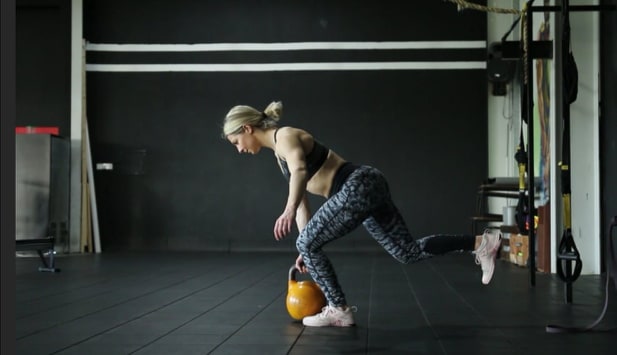1. Hip Thrusts
The hip thrust is a glute exercise designed to improve your strength, speed and power by emphasizing optimal hip extension.
How to execute:
Place the upper of your back at the edge of a bench. Place a bar or a weight just above your pubic bone in the lower abdominal region. Push through your heels to lift your hips up till you reach full hip extension. Try to posteriorly tilt your pelvis and squeeze your glutes for 2 seconds. Keep your core braced and your head forward with your chin tucked in. Your shins should stay vertical at the top position. Single leg hip thrusts, banded hip thrusts, and weighted hip thrusts are all great variations for building glute strength and physique. If you are a beginner, start with floor glute bridges and slowly progress to the hip thrust.
2. Lateral band walk
This exercise aims at activating and strengthening your glutes and hip abductors, as well as improving hip stability. Lateral band walks target the upper gluteus maximus and gluteus medius.
How to execute:
Position a band above or below your knees to make the exercise easier or harder, respectively. Push your hips back and drive laterally into the ground with your grounded leg while stepping with your opposite leg. Try to keep tension to the band. Don’t let your knees cave in.
3. Monster walk
Monster walks are designed to activate the muscles in your hips and glutes.
How to execute:
For the monster walk push your hips back, then start walking in a diagonal way by bringing the foot towards your center line and then back out again with each step. Try to push hard to the ground with each step. You want to take “monster,” big steps, keeping your feet as wide apart as you can while moving forward. Then walk backwards in the same manner. You can try a low monster walk (squat) or a straighter leg monster walk. Try not to rotate your hips too much as you walk and keep your toes pointing forwards. Make this exercise easier by placing the band above the knees.
4. Deficit lunges
Deficit lunges can be a great tool for developing lower body and glute strength. When you perform deficit lunges, because you’re lunging from a deficit, the trailing knee gets to travel “below ground level”. That means you get a deeper hip flexion and more work for the glutes is required to extend the hip and return to the start position.
How to execute:
Stand on a plate (10-25kg) or step depending on your level. Take a big step backwards and slowly descend. Try to touch your rear knee to the ground without making any sound. Push through the heel of your front leg to get back into the starting position. Repeat 10 times, rest for around 10-20’’ and then switch leg. Hold 2 dumbbells if you want to make it harder or just go bodyweight.
5. Side Lying hip raises
This is an advanced hip abduction exercise that is similar to the side lying clamshell.
How to execute:
In a side lying position, with your elbow on the ground, bent your knees and hips. Push through your grounded knee and elbow to raise your body, while abducting both hips, and reach full hip extension. Then, slowly descent until you reach the starting position. You can add a resistance band above your knees for added difficulty. If you find this exercise hard, regress to the clamshell exercise.
6. Single leg Deadlift
Most lifters use the deadlift as a measure of strength; however, you don’t need to lift heavy to get the most of this exercise. I really like the single leg variation as it improves not only lower body strength, but also balance and core stability.
How to execute:
Stand with your feet underneath your hips. Hold the dumbbell on one hand and try to keep the weight centered over one leg. Hinge from your hip, tilt your torso forward with neutral spine, and send the opposite leg back, either straightened or bent. Bent the knee of the planted foot slightly, keep your shin as vertical as possible and your hips square. To complete the rep, bring your rear leg forward and elevate your torso to reach full hip extension. If you struggle with the single leg variation, even without holding any weights, start with bilateral deadlifts or bodyweight single leg hinges.
7. Step ups
Step ups not only improve hip flexion mobility, coordination, and lower body strength, but can also help in performing daily activities such as climbing the stairs.
How to execute:
Stand to the side of the box and lean forward with a neutral spine. Push the elevated leg on the box till you reach full hip extension. Knee and toes should point the same way. Lower yourself in a slow and controlled way while keeping your hips square. Try not to use the rear leg to push off the ground. If you are a beginner, start out with a smaller step! If you want to make it even harder, grab some weight!
